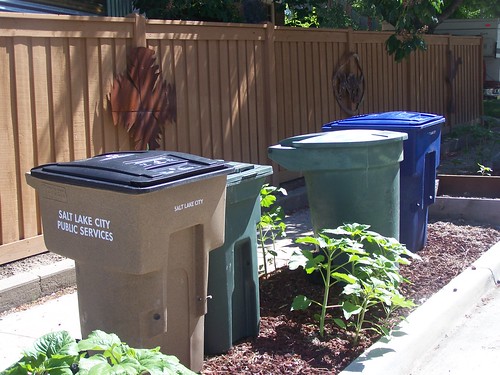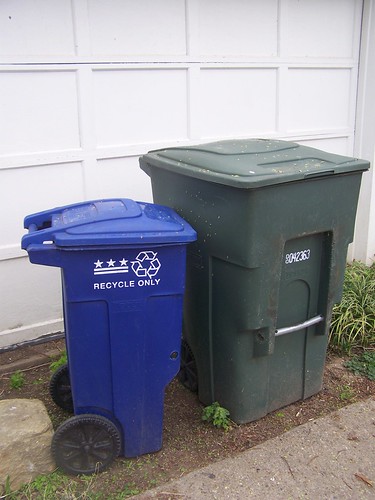A way for DC to begin adding yard waste collection as a separate element of waste collection and reduction programming

Salt Lake City has four types of collection media for solid waste. They collect paper, plastic, and metal in blue cans, have separate rectangular bins for glass (which only recently they started to collect), while trash is collected from green cans, and yard waste is put into the largest can size, which is colored brown.
For years, I have written that DC should separately collect yard waste, as is done in some of the neighboring jurisdictions, but we don't.
The State of Maryland sets (imposes) high waste diversion requirements on the counties, which is why they have active solid waste diversion programs. For example, the Leafgro compost available in the region is made from leaves from Montgomery County.
Our household composts so we generate very little yard waste, but it's true that our "secondary" compost pile (certain kinds of weeds, branches) maintains its height despite the break down of the materials over time, because we constantly add to it each season, after rain storms, etc.
(In fact, since we lost one of our big trees, now I "steal" some of my neighbors collected leaves, so I have enough for the compost pile for the next year.)
In April I wrote an entry, "Waste in not using products for the normal 'useful' life: sidewalks and trash cans," where I complained that city plans to replace all of the city's trash cans don't make a lot of sense because my sense is that 90% of DC's trash cans have many years of useful life ahead of them.
But seeing the yard waste cans in Salt Lake City yesterday made me realize that a way forward on this issue in DC would be to recognize that DC is not "One City" (the tagline used by the Mayor and Executive Branch agencies), but two cities, and we could have differentiated waste collection programs (we already do in one sense) for yard waste, where we have only one program now.
Rowhouse neighborhoods at the core have different waste collection needs from the detached-housing dominated neighborhoods comprising the outer city
The "problem" with trash collection is that DC is two different cities--the rowhouse city mostly in the core and the outer city where single family detached housing predominates. In the core of the city, households have small yards and don't have alley access. They don't generate a lot of yard waste.
 In the outer city (where we live), where much of the housing stock is detached with lots large enough to store bigger trash cans and most households generate lots of yard waste, which unless they compost, is put out for trash collection.
In the outer city (where we live), where much of the housing stock is detached with lots large enough to store bigger trash cans and most households generate lots of yard waste, which unless they compost, is put out for trash collection.Right: trash and recycling cans in the outer city. Note that in the core of the city, the trash cans they use are the same size as the blue recycling cans.
The city does recognize the "two cities" in trash collection policies
The city does treat the core differently from the outer city as it relates to trash collection.
While the city's recycling cans are all the same size, the trash cans in the core are smaller than the cans in the outer city. And in the core, they get trash collection twice each week and recycling service once/week.
This is because of the idea that there are more rodents in the core, plus the smell of trash can build up in small places, etc.
In the outer city, we have larger trash cans and once per week trash pick up. For most of the blocks with alleys, the trash cans are "out of mind" stored on the alley side of the property.
Let's add yard waste diversion and collection programs to the outer city
Households in the outer city generate a lot of yard waste. The city does do leaf pickup in the fall, and those leaves are composted. But many leaves and thousands of tons of yard waste go into the regular "trash" stream, to be burned in Fairfax County for energy and DC pays for the privilege (around $30/ton of trash), because we don't have a yard waste diversion program.
In the core of the city most households don't generate a lot of yard waste, because they have minimal yards--although they still do generate some of this kind of "trash" (as well as compostable material).
In the outer city at the very least, there should be an additional pick up strictly for yard waste, just as is done in places like Montgomery County, many communities in Prince George's County, and Salt Lake City (there the cans are bigger than our largest, and the color of the can is brown).
If we were big on innovation as a city--which for the most part we are not--it could be tested in some pilot neighborhoods rather than rolled out to the entire city in one fell swoop.
It would require a lot of "training" to get people to do it--MoCo has been doing it for years and still has an extensive outreach program as part of their division of solid waste--but it fits in with DC's new sustainability goals, would add some local jobs (more trash collection personnel, and probably some more trucks would be required, plus outreach personnel), on the other hand we would cut "landfill" costs. Fairfax County would make less money and need to find more trash to burn but that's not our problem.
Basically, what I am saying that is instead of buying new cans when 90% of the cans are functional, let's buy some new recycling cans that are bigger and offer those to the households that need them (like my household), and let's buy a bunch of yard waste cans for a few pilot neighborhoods, and begin the process of DC shifting how it collects "trash," by instead diverting what isn't trash, in this case, "yard trim" or "yard waste" to better uses.
-- Montgomery County Yard Trim webpage
-- Montgomery County Composting program
-- Montgomery County instructions on how to compost
-- Montgomery County neighborhood mulch distribution program
Labels: environment-green, green-environment-urban, recycling, resource management, sanitation and solid waste, sustainability



0 Comments:
Post a Comment
<< Home